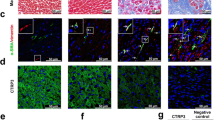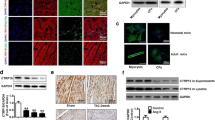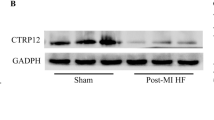Abstract
C1q/tumor necrosis factor-related protein-6 (CTRP6) is a newly identified adiponectin paralog with modulation effects on metabolism and inflammation. However, the cardiovascular function of CTRP6 remains unknown. This study aimed to determine its role in cardiac fibrosis and explore the possible mechanism. Myocardial infarction (MI) was induced by left anterior descending coronary artery ligation in rats. CTRP6 was mainly expressed in the cytoplasm of adult rat cardiomyocytes and significantly decreased in the border and infarct zones post-MI. Adenovirus-mediated CTRP6 delivery improved cardiac function, attenuated cardiac hypertrophy, alleviated cardiac fibrosis, and inhibited myofibroblast differentiation as well as the expression of collagen I, collagen III, and connective tissue growth factor post-MI. In cultured adult rat cardiac fibroblasts (CFs), exogenous or cardiomyocyte-secreted CTRP6 inhibited, whereas knockdown of CTRP6 facilitated transforming growth factor-β1 (TGF-β1)-induced expression of α-smooth muscle actin, smooth muscle 22α, and profibrotic molecules. CTRP6 had no effect on CFs proliferation but attenuated CFs migration induced by TGF-β1. CTRP6 increased the phosphorylation of AMP-activated protein kinase (AMPK) and Akt in CFs and post-MI hearts. Pretreatment with adenine 9-β-d-arabinofuranoside (AraA), an AMPK inhibitor, or LY294002, a phosphatidylinositol-3-kinase (PI3 K) inhibitor, abolished the protective effect of CTRP6 on TGF-β1-induced profibrotic response. Furthermore, CTRP6 had no effect on TGF-β1-induced Smad3 phosphorylation and nuclear translocation, whereas significantly decreased TGF-β1-induced RhoA activation and myocardin-related transcription factor-A (MRTF-A) nuclear translocation, and these effects were blocked by AMPK or Akt inhibition. In conclusion, CTRP6 attenuates cardiac fibrosis via inhibiting myofibroblast differentiation. AMPK and Akt activation are responsible for the CTRP6-mediated anti-fibrotic effect by targeting RhoA/MRTF-A pathway.








Similar content being viewed by others
References
Biernacka A, Dobaczewski M, Frangogiannis NG (2011) TGF-beta signaling in fibrosis. Growth Factors 29:196–202. doi:10.3109/08977194.2011.595714
Bujak M, Frangogiannis NG (2007) The role of TGF-beta signaling in myocardial infarction and cardiac remodeling. Cardiovasc Res 74:184–195. doi:10.1016/j.cardiores.2006.10.002
Cao T, Gao Z, Gu L, Chen M, Yang B, Cao K, Huang H, Li M (2014) AdipoR1/APPL1 potentiates the protective effects of globular adiponectin on angiotensin II-induced cardiac hypertrophy and fibrosis in neonatal rat atrial myocytes and fibroblasts. PLoS One 9:e103793. doi:10.1371/journal.pone.0103793
Cavin S, Maric D, Diviani D (2014) A-kinase anchoring protein-Lbc promotes pro-fibrotic signaling in cardiac fibroblasts. Biochim Biophys Acta 1843:335–345. doi:10.1016/j.bbamcr.2013.11.008
Cieslik KA, Taffet GE, Crawford JR, Trial J, Mejia Osuna P, Entman ML (2013) AICAR-dependent AMPK activation improves scar formation in the aged heart in a murine model of reperfused myocardial infarction. J Mol Cell Cardiol 63:26–36. doi:10.1016/j.yjmcc.2013.07.005
Crider BJ, Risinger GM Jr, Haaksma CJ, Howard EW, Tomasek JJ (2011) Myocardin-related transcription factors A and B are key regulators of TGF-beta1-induced fibroblast to myofibroblast differentiation. J Invest Dermatol 131:2378–2385. doi:10.1038/jid.2011.219
Davis J, Molkentin JD (2014) Myofibroblasts: trust your heart and let fate decide. J Mol Cell Cardiol 70:9–18. doi:10.1016/j.yjmcc.2013.10.019
Dobaczewski M, Bujak M, Li N, Gonzalez-Quesada C, Mendoza LH, Wang XF, Frangogiannis NG (2010) Smad3 signaling critically regulates fibroblast phenotype and function in healing myocardial infarction. Circ Res 107:418–428. doi:10.1161/CIRCRESAHA.109.216101
Dobaczewski M, Chen W, Frangogiannis NG (2011) Transforming growth factor (TGF)-beta signaling in cardiac remodeling. J Mol Cell Cardiol 51:600–606. doi:10.1016/j.yjmcc.2010.10.033
Fu YN, Xiao H, Ma XW, Jiang SY, Xu M, Zhang YY (2011) Metformin attenuates pressure overload-induced cardiac hypertrophy via AMPK activation. Acta Pharmacol Sin 32:879–887. doi:10.1038/aps.2010.229
Fujita K, Maeda N, Sonoda M, Ohashi K, Hibuse T, Nishizawa H, Nishida M, Hiuge A, Kurata A, Kihara S, Shimomura I, Funahashi T (2008) Adiponectin protects against angiotensin II-induced cardiac fibrosis through activation of PPAR-alpha. Arterioscler Thromb Vasc Biol 28:863–870. doi:10.1161/ATVBAHA.107.156687
Fujiu K, Nagai R (2013) Contributions of cardiomyocyte-cardiac fibroblast-immune cell interactions in heart failure development. Basic Res Cardiol 108:357. doi:10.1007/s00395-013-0357-x
Guo J, Bian Y, Bai R, Li H, Fu M, Xiao C (2013) Globular adiponectin attenuates myocardial ischemia/reperfusion injury by upregulating endoplasmic reticulum Ca2+-ATPase activity and inhibiting endoplasmic reticulum stress. J Cardiovasc Pharmacol 62:143–153. doi:10.1097/FJC.0b013e31829521af
Heusch G, Libby P, Gersh B, Yellon D, Bohm M, Lopaschuk G, Opie L (2014) Cardiovascular remodelling in coronary artery disease and heart failure. Lancet 383:1933–1943. doi:10.1016/S0140-6736(14)60107-0
Hofmann C, Chen N, Obermeier F, Paul G, Buechler C, Kopp A, Falk W, Schaffler A (2011) C1q/TNF-related protein-3 (CTRP-3) is secreted by visceral adipose tissue and exerts antiinflammatory and antifibrotic effects in primary human colonic fibroblasts. Inflamm Bowel Dis 17:2462–2471. doi:10.1002/ibd.21647
Kakkar R, Lee RT (2010) Intramyocardial fibroblast myocyte communication. Circ Res 106:47–57. doi:10.1161/CIRCRESAHA.109.207456
Kambara T, Ohashi K, Shibata R, Ogura Y, Maruyama S, Enomoto T, Uemura Y, Shimizu Y, Yuasa D, Matsuo K, Miyabe M, Kataoka Y, Murohara T, Ouchi N (2012) CTRP9 protein protects against myocardial injury following ischemia-reperfusion through AMP-activated protein kinase (AMPK)-dependent mechanism. J Biol Chem 287:18965–18973. doi:10.1074/jbc.M112.357939
Kim M, Tian R (2011) Targeting AMPK for cardiac protection: opportunities and challenges. J Mol Cell Cardiol 51:548–553. doi:10.1016/j.yjmcc.2010.12.004
Kim MJ, Lee W, Park EJ, Park SY (2010) C1qTNF-related protein-6 increases the expression of interleukin-10 in macrophages. Mol Cells 30:59–64. doi:10.1007/s10059-010-0088-x
Kleinbongard P, Schulz R, Heusch G (2011) TNFalpha in myocardial ischemia/reperfusion, remodeling and heart failure. Heart Fail Rev 16:49–69. doi:10.1007/s10741-010-9180-8
Kong P, Christia P, Frangogiannis NG (2014) The pathogenesis of cardiac fibrosis. Cell Mol Life Sci 71:549–574. doi:10.1007/s00018-013-1349-6
Lajiness JD, Conway SJ (2014) Origin, development, and differentiation of cardiac fibroblasts. J Mol Cell Cardiol 70:2–8. doi:10.1016/j.yjmcc.2013.11.003
Lee W, Kim MJ, Park EJ, Choi YJ, Park SY (2010) C1qTNF-related protein-6 mediates fatty acid oxidation via the activation of the AMP-activated protein kinase. FEBS Lett 584:968–972. doi:10.1016/j.febslet.2010.01.040
Li L, Fan D, Wang C, Wang JY, Cui XB, Wu D, Zhou Y, Wu LL (2011) Angiotensin II increases periostin expression via Ras/p38 MAPK/CREB and ERK1/2/TGF-beta1 pathways in cardiac fibroblasts. Cardiovasc Res 91:80–89. doi:10.1093/cvr/cvr067
Li L, Zhang ZG, Lei H, Wang C, Wu LP, Wang JY, Fu FY, Zhu WG, Wu LL (2013) Angiotensin II reduces cardiac AdipoR1 expression through AT1 receptor/ROS/ERK1/2/c-Myc pathway. PLoS One 8:e49915. doi:10.1371/journal.pone.0049915
Morrison A, Li J (2011) PPAR-gamma and AMPK–advantageous targets for myocardial ischemia/reperfusion therapy. Biochem Pharmacol 82:195–200. doi:10.1016/j.bcp.2011.04.004
Nickola MW, Wold LE, Colligan PB, Wang GJ, Samson WK, Ren J (2000) Leptin attenuates cardiac contraction in rat ventricular myocytes role of NO. Hypertension 36:501–505. doi:10.1161/01.HYP.36.4.501
Ouchi N, Shibata R, Walsh K (2006) Cardioprotection by adiponectin. Trends Cardiovasc Med 16:141–146. doi:10.1016/j.tcm.2006.03.001
Pol CJ, Muller A, Zuidwijk MJ, van Deel ED, Kaptein E, Saba A, Marchini M, Zucchi R, Visser TJ, Paulus WJ, Duncker DJ, Simonides WS (2011) Left-ventricular remodeling after myocardial infarction is associated with a cardiomyocyte-specific hypothyroid condition. Endocrinology 152:669–679. doi:10.1210/en.2010-0431
Rahaman SO, Grove LM, Paruchuri S, Southern BD, Abraham S, Niese KA, Scheraga RG, Ghosh S, Thodeti CK, Zhang DX, Moran MM, Schilling WP, Tschumperlin DJ, Olman MA (2014) TRPV4 mediates myofibroblast differentiation and pulmonary fibrosis in mice. J Clin Invest 124:5225–5238. doi:10.1172/JCI75331
Schäffler A, Buechler C (2012) CTRP family: linking immunity to metabolism. Trends Endocrinol Metab 23:194–204. doi:10.1016/j.tem.2011.12.003
Shibata R, Izumiya Y, Sato K, Papanicolaou K, Kihara S, Colucci WS, Sam F, Ouchi N, Walsh K (2007) Adiponectin protects against the development of systolic dysfunction following myocardial infarction. J Mol Cell Cardiol 42:1065–1074. doi:10.1016/j.yjmcc.2007.03.808
Small EM (2012) The actin-MRTF-SRF gene regulatory axis and myofibroblast differentiation. J Cardiovasc Transl Res 5:794–804. doi:10.1007/s12265-012-9397-0
Small EM, Thatcher JE, Sutherland LB, Kinoshita H, Gerard RD, Richardson JA, Dimaio JM, Sadek H, Kuwahara K, Olson EN (2010) Myocardin-related transcription factor-A controls myofibroblast activation and fibrosis in response to myocardial infarction. Circ Res 107:294–304. doi:10.1161/CIRCRESAHA.110.223172
Su H, Yuan Y, Wang XM, Lau WB, Wang Y, Wang X, Gao E, Koch WJ, Ma XL (2013) Inhibition of CTRP9, a novel and cardiac-abundantly expressed cell survival molecule, by TNFalpha-initiated oxidative signaling contributes to exacerbated cardiac injury in diabetic mice. Basic Res Cardiol 108:315. doi:10.1007/s00395-012-0315-z
Sumida A, Horiba M, Ishiguro H, Takenaka H, Ueda N, Ooboshi H, Opthof T, Kadomatsu K, Kodama I (2010) Midkine gene transfer after myocardial infarction in rats prevents remodelling and ameliorates cardiac dysfunction. Cardiovasc Res 86:113–121. doi:10.1093/cvr/cvp386
Sun Y, Yi W, Yuan Y, Lau WB, Yi D, Wang X, Wang Y, Su H, Gao E, Koch WJ, Ma XL (2013) C1q/tumor necrosis factor-related protein-9, a novel adipocyte-derived cytokine, attenuates adverse remodeling in the ischemic mouse heart via protein kinase A activation. Circulation 128:S113–S120. doi:10.1161/CIRCULATIONAHA.112.000010
Sussman MA, Volkers M, Fischer K, Bailey B, Cottage CT, Din S, Gude N, Avitabile D, Alvarez R, Sundararaman B, Quijada P, Mason M, Konstandin MH, Malhowski A, Cheng Z, Khan M, McGregor M (2011) Myocardial AKT: the omnipresent nexus. Physiol Rev 91:1023–1070. doi:10.1152/physrev.00024.2010
Sutton MG, Sharpe N (2000) Left ventricular remodeling after myocardial infarction: pathophysiology and therapy. Circulation 101:2981–2988. doi:10.1161/01.CIR.101.25.2981
Takeuchi T, Adachi Y, Nagayama T (2011) Expression of a secretory protein C1qTNF6, a C1qTNF family member, in hepatocellular carcinoma. Anal Cell Pathol (Amst) 34:113–121. doi:10.3233/ACP-2011-009
Tseliou E, Reich H, de Couto G, Terrovitis J, Sun B, Liu W, Marban E (2014) Cardiospheres reverse adverse remodeling in chronic rat myocardial infarction: roles of soluble endoglin and Tgf-beta signaling. Basic Res Cardiol 109:443. doi:10.1007/s00395-014-0443-8
Tullio F, Angotti C, Perrelli MG, Penna C, Pagliaro P (2013) Redox balance and cardioprotection. Basic Res Cardiol 108:392. doi:10.1007/s00395-013-0392-7
van Nieuwenhoven FA, Turner NA (2013) The role of cardiac fibroblasts in the transition from inflammation to fibrosis following myocardial infarction. Vascul Pharmacol 58:182–188. doi:10.1016/j.vph.2012.07.003
Wang Y, Lau WB, Gao E, Tao L, Yuan Y, Li R, Wang X, Koch WJ, Ma XL (2010) Cardiomyocyte-derived adiponectin is biologically active in protecting against myocardial ischemia-reperfusion injury. Am J Physiol Endocrinol Metab 298:E663–E670. doi:10.1152/ajpendo.00663.2009
Wong GW, Krawczyk SA, Kitidis-Mitrokostas C, Revett T, Gimeno R, Lodish HF (2008) Molecular, biochemical and functional characterizations of C1q/TNF family members: adipose-tissue-selective expression patterns, regulation by PPAR-gamma agonist, cysteine-mediated oligomerizations, combinatorial associations and metabolic functions. Biochem J 416:161–177. doi:10.1042/BJ20081240
Wu WJ, Mo L, Zhao CZ, Zhao C, Chen YS, Pang WJ, Yang GS (2015) Knockdown of CTRP6 inhibits adipogenesis via lipogenic marker genes and Erk1/2 signalling pathway. Cell Biol Int 39:554–562. doi:10.1002/cbin.10422
Yi W, Sun Y, Yuan Y, Lau WB, Zheng Q, Wang X, Wang Y, Shang X, Gao E, Koch WJ, Ma XL (2012) C1q/tumor necrosis factor-related protein-3, a newly identified adipokine, is a novel antiapoptotic, proangiogenic, and cardioprotective molecule in the ischemic mouse heart. Circulation 125:3159–3169. doi:10.1161/CIRCULATIONAHA.112.099937
Yi X, Li X, Zhou Y, Ren S, Wan W, Feng G, Jiang X (2014) Hepatocyte growth factor regulates the TGF-beta1-induced proliferation, differentiation and secretory function of cardiac fibroblasts. Int J Mol Med 34:381–390. doi:10.3892/ijmm.2014.1782
Zhang P, Su J, Mende U (2012) Cross talk between cardiac myocytes and fibroblasts: from multiscale investigative approaches to mechanisms and functional consequences. Am J Physiol Heart Circ Physiol 303:H1385–H1396. doi:10.1152/ajpheart.01167.2011
Zhang YJ, Yang SH, Li MH, Iqbal J, Bourantas CV, Mi QY, Yu YH, Li JJ, Zhao SL, Tian NL, Chen SL (2014) Berberine attenuates adverse left ventricular remodeling and cardiac dysfunction after acute myocardial infarction in rats: role of autophagy. Clin Exp Pharmacol Physiol 41:995–1002. doi:10.1111/1440-1681.12309
Zhou Y, Wang JY, Feng H, Wang C, Li L, Wu D, Lei H, Li H, Wu LL (2014) Overexpression of c1q/tumor necrosis factor-related protein-3 promotes phosphate-induced vascular smooth muscle cell calcification both in vivo and in vitro. Arterioscler Thromb Vasc Biol 34:1002–1010. doi:10.1161/ATVBAHA.114.303301
Acknowledgments
We would like to thank Dr. Sudhiranjan Gupta (Texas A&M Health Science Center, USA) for the valuable scientific advices. This study was supported by the grants from the National Natural Science Foundation of China (Nos. 81270158, 81470398 and 81370192).
Conflict of interest
None.
Author information
Authors and Affiliations
Corresponding author
Additional information
H. Lei and D. Wu contributed equally to this work.
Electronic supplementary material
Below is the link to the electronic supplementary material.
Rights and permissions
About this article
Cite this article
Lei, H., Wu, D., Wang, JY. et al. C1q/tumor necrosis factor-related protein-6 attenuates post-infarct cardiac fibrosis by targeting RhoA/MRTF-A pathway and inhibiting myofibroblast differentiation. Basic Res Cardiol 110, 35 (2015). https://doi.org/10.1007/s00395-015-0492-7
Received:
Accepted:
Published:
DOI: https://doi.org/10.1007/s00395-015-0492-7




